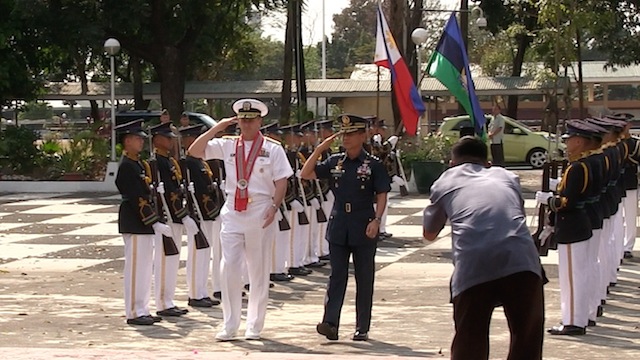
ARRIVAL HONORS. US navy chief of naval operations Admiral Admiral Jonathan Greenert. Photo by Carmela Fonbuena
Don't be surprised if you continue to hear US officials sending
"The
preponderance and collection of activity by China US rhetoric
in following international laws in the South China Sea .
(READ: Beijing slams 'irresponsible' US warning on South China Sea
and US lawmakers support PH legal track on China)
Greenert is in
the Philippines US
He was at Camp Aguinaldo
on Thursday, February 13, to pay a courtesy call on Defense Secretary Voltaire
Gazmin and to speak before students of the National
Defense College
of the Philippines

[Video: Expect stronger US message VS China aggression
http://www.youtube.com/watch?v=MPxEWBx3QmE]
More
The Philippines has one of the weakest militaries in
Asia but it is one of the most vocal in challenging China Philippines
President Benigno
Aquino III was quoted saying the Philippine and the US
are close to finalizing a military-to-military agreement allowing increased
rotational presence of troops in the Philippines
In the past two
decades, Greenert said the US US
"What does
it mean to the Philippines
Super Typhoon
Yolanda showed last year the advantages of the presence of US troops and assets
in the Philippines US
If push comes to
shove, Greenert vows the US
will be around to help the Philippines US
would do if China
Greenert replied:
"Of course, we will help you.... We have an obligation because of the
treaty."
But Greenert said
dialogue is the best way to resolve the tension. "Move the dialogue less
in the direction where we are going to end in confrontation and combat. It
doesn't have to be that way if we use the process that we put in place. We
should exhaust that," he said.
In April,
countries involved in maritime disputes will try to do just that. The different
navies will gather in China US is invited and the Philippines
"I don’t
know if I'm optimistic as much as I'm saying we're going to be deliberate. What
the heck is this? We need to close this up. All nations seem to disagree except
for one," he said.
http://www.rappler.com/nation/50521-us-naval-operations-china

No comments:
Post a Comment
Note: Only a member of this blog may post a comment.